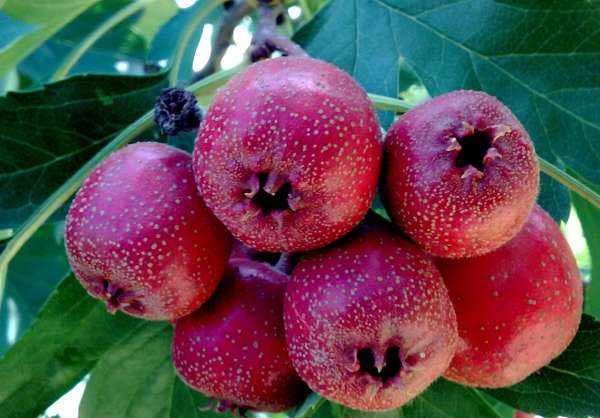When used as medicine, hawthorn berry mainly refers to the ripe fruits of Crataegus pinnatifida Bge.var.major N.E.Br. or Crataegus pinnatifida Bge., which are members of the family Rosaceae. Other names of hawthorn also include Crataegi Fructus, Fructus Crataegi, fruit of Crataegus pinnatifida, Chinese hawthorn, Crateagus oxycanthus, Chinese haw, Whitethorn, Thorn-apple tree, Shan-cha, and so on. In China it is mainly produced in Henan, Shandong, Hebei, and Shandong. And the hawthorn fruits cultivated from Shandong province are generally considered high quality. It is usually harvested in autumn when fruits are ripe, sliced, and dried. Medicinally it is used raw or fried. Besides of the mentioned species, there are many other similar ones used as Shan Zha too, such as Crataegus kansuensis Wils., Crataegus sanguinea Pall., Crataegus hupehensis Sarg., Crataegus scabrifolia (Franch.) Rehd., Malusyunnanensis schneid., Mprunifolia (Willd.) Bo-rkh., M.asiatica Nakai., Docynia delavayi(Franch.)Schneid., and so on.
HAWTHORN BERRY BENEFITS
It is reported that the combination of hawthorn berry with other herbs can be a good remedy for a variety of diseases, such as indigestion, anorexia in children, infant diarrhea, dysentery, abdominal pain, postpartum blood stasis, and more.
a) 89 cases of hyperlipidemia in middle-aged and elderly adult have been treated with hawthorn-based Jiang Zhi Le (literally Lipid-lowering Happy). The results showed that the efficiency of lowering cholesterol and triglycerides were 69.49% and 80.28% respectively. What's more, it can still improve a poor appetite, lassitude, lack of energy, high blood pressure, and other symptoms.
b) 186 cases of angina pectoris have been treated with Xin Xu Ning Pin, which is made from the extract of hawthorn and Ge Gen (Kudzu Root). And the efficiency is 89.87%. In addition, it has a very good blood pressure and lipid-lowering efficacy too.
c) 105 cases of acute and chronic pyelonephritis have been treated with decoction of 90g hawthorn on daily basis (treatment of children with reduced-dose). And the remedy was with a good result.

Hawthorn Berry
HAWTHORN BERRY FORMULAS ON HERBAL REMEDIES
The Chinese Materia Medica thinks that it is sour-sweet in flavor and slightly warm and non-toxic in nature. And it goes to meridians of spleen, stomach, liver, and lung. Common functions are helping digestion and dissolving stasis. Main hawthorn berry uses and indications are accumulated meats and greasy foods, diarrhea and dysentery, abdominal bloating and pain, blood stasis induced Dysmenorrhea, Amenorrhea, postpartum abdominal pain, and lochia. Recommended hawthorn berry dosage is 3 to 10 grams in decoction. And it can be available in the forms of hawthorn berry tea, extract, supplement, powder, syrup, tincture, capsules, and more.
1) Yun Qi San from Zheng Zhi Zhun Sheng (The Level-line of Patterns and Treatment). It is formulated with Mu Xiang (Costus) and Qing Pi (Orange Rind) to treat abdominal distention and pain due to food stagnation.
2) Bao He Wan from Dan Xi Xin Fa (Dan Xi's Experiential Methods). It is combined with Shen Qu (Massa Medica Fermentata), Mai Ya (Barley Malt), Ban Xia (Pinellia), Fu Ling (Poria), Chen Pi (Citrus Peel), Lian Qiao (Forsythia), and Lai Fu Zi (Radish Seeds) to cure dyspepsia and abdominal pain and fullness.
3) Jian Pi Wan from The Level-line of Patterns and Treatment. It is matched with Bai Zhu (White Atractylodes), Mu Xiang (Costus), Huang Lian (Coptis Root), Gan Cao (Licorice Root), Ren Shen (Ginseng), Sha Ren (Cardamom Seed), Shan Yao (Chinese Yam), etc. to heal Chronic gastritis, chronic enteritis, indigestion, and other diseases that are caused by food stagnation and spleen deficiency.
4) Tong Yu Jian from Jing Yue Quan Shu (Jingyue's Complete Works). It is joined with Dang Gui (Dong Quai), Xiang Fu (Cyperus), and Hong Hua (Safflower Flower) to treat postpartum abdominal pain due to blood stasis, lochia, dysmenorrhea, and amenorrhea.

![Diseases, Symptoms, tcm, [tcmwindow.com]](/uploadFile/adImg/2015/11/11/f5cbfcc0-4df5-4646-9b9a-f316651a0199.jpg)





